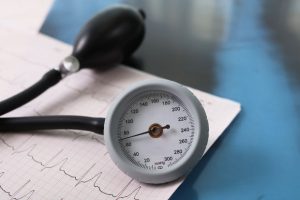
Most people are familiar with the term systolic blood pressure, but it isn’t an adequate measure of perfusion (the delivery of blood). Mean arterial pressure can help determine actual pressure of blood against the arterial walls. The arteries are fibrous and muscular vessels that carry blood from the heart to other structures throughout the human body.
Fortunately, the majority of blood pressure machines in hospitals will calculate mean arterial pressure (MAP) for us. In intensive care situations, MAP is often monitored with invasive tools, such as an arterial line, which is a thin catheter inserted into an artery.
What should your mean arterial pressure be?
Normal MAP ranges are between 70 and 110 mm Hg. A minimum of 60 is needed to provide enough blood to nourish the coronary arteries, kidneys, and brain. When MAP falls below 60 for a considerable amount of time, organs may become deprived of the oxygen they need.
Many people use this formula to measure mean arterial pressure: diastolic pressure + (1/3) x pulse pressure. Pulse pressure is systolic pressure minus diastolic pressure. Cardiac specialists say this isn’t the best way to calculate MAP because the reading isn’t an accurate measure, since ventricles only spend about one-third of the time in systole, which is the working stage of the cycle.
How is the mean arterial pressure regulated?
Mean arterial pressure is regulated by changes in cardiac output and systemic vascular resistance, which refers to the resistance to blood flow by all of the systemic vasculature. Systemic vasculature includes vessels and capillaries.
Cardiac output is determined by stroke volume and heart rate. Stroke volume is determined by an agent that can alter the force of muscular contractions. It is also impacted by the effects of what cardiac specialists refer to as afterload on stroke volume. If there are changes in the volume of blood, it can alter the afterload. Afterload is something that can happen as we age. Stiff and thick arteries are more common in seniors due to degeneration, so there is less contraction in the ventricle. When stroke volume decreases, less blood is being injected from the heart with each contraction.
Renal function, including the handling of sodium and water, can also impact blood volume. Additionally, there are situations where the diameter of vessels can change, having an impact on cardiac output too.
The ability of a blood vessel wall to expand and contract with changes in pressure is an important feature of arteries and veins.
How to measure mean arterial pressure?
Just like blood pressure, mean arterial pressure is measured in millimeters of mercury. True mean arterial pressure (MAP) can only be calculated using complex calculations and invasive monitors. It can also be calculated using a formula of systolic blood pressure (SBP) and diastolic blood pressure (DBP). You have to double the DBP and add the sum to the SBP. You then divide by three. If for example, a person’s blood pressure were 83mmHg/50mmHg, then his MAP would be 61 mm Hg.
There is an alternative way to calculate. You can first determine the pulse pressure by subtracting the DBP from the SBP, and then divide that by three. Once you have done that, add the DBP to get your final calculation.
Mean arterial pressure significance
As mentioned earlier, a normal range for mean arterial pressure is 70 to 110 mm Hg. A mean arterial pressure in the high range could be an indication that the heart has to work much harder than it should. This is causing stress on the heart. High MAP can result in advanced heart disease, blood clots, heart attack, and stroke. When high mean arterial pressure is ongoing, heart muscles will enlarge and grow thicker, and jeopardize life expectancy. When MAP goes up quickly in a short period of time, organs can fail. A mean arterial pressure in the high range isn’t the only concern though, low is also problematic.
Low MAP can also be fatal if left untreated. Pressure readings less than 60 mm Hg must be addressed. In this case, when organs are not getting the blood they need, you can go into shock and organs can fail. Low MAP can be caused by sepsis, hemorrhaging, stroke, or some sort of trauma.
Here are some situations where perfusion of organs might come into play and impact MAP:
- Head injuries
- Cardiac situations
- Septic shock
- Abdominal aneurysm
Mean arterial pressure (MAP) during exercise
It is interesting to note that when you exercise, your body tends to compensate for change in MAP through reflex. You might notice that if your blood pressure rises during exercising, your MAP will stay about the same. As you go through your day, your blood pressure is monitored by your central nervous system. Mild changes to certain functions keep it fairly steady, thanks to what is called, baroreceptor reflexes. These receptors can read the stretching of arterial walls, veins, and the heart. When blood pressure rises and the walls stretch, the receptors send a signal to the brain, telling it to relax or tighten the walls. This quickly restores blood pressure, as well as MAP in those who are healthy.
There are situations where it is very important to monitor mean arterial pressure. For example, if you have been diagnosed with sepsis or thickened arteries. Those who have experienced a head injury or stroke should have their MAP monitored as well. Treatment for low or high MAP will depend on the cause, but in many cases blood pressure medications are prescribed, along with lifestyle adjustments.
If you are still unsure about mean arterial pressure, including how to have it monitored or how to measure MAP, don’t hesitate to discuss it with your doctor. No doubt after reading this, you do understand the significance of mean arterial pressure, especially as we get older.
Related: Fluctuating blood pressure: Causes and treatments